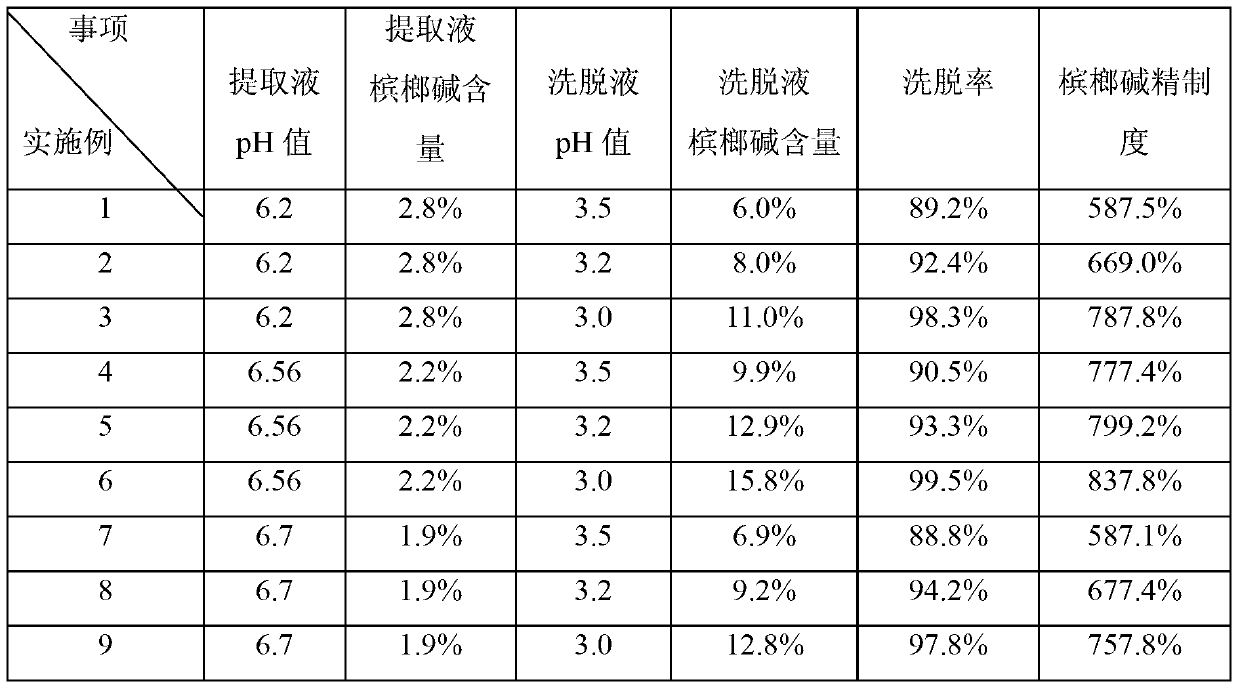Method of enriching arecoline by using H103 type macroporous adsorption resin
A technology of H103, pore adsorption, applied in directions such as organic chemistry, can solve the problem of no separation and purification method of arecoline, and achieve the effects of simple and easy operation, convenient recovery and reduced use cost.
- Summary
- Abstract
- Description
- Claims
- Application Information
AI Technical Summary
Problems solved by technology
Method used
Image
Examples
Embodiment 1
[0028] Dry the betel nut and crush it into dry betel nut powder, weigh 1 kg and add 4 kg of distilled water to soak for 1 hour, then ultrasonically extract for 15 minutes, filter to obtain 4 kg of the extract, adjust the pH of the extract to 6.2 with 0.1 mol / mL hydrochloric acid solution, and set aside. Weigh 0.6 kg (wet weight) of the H103 type macroporous resin and put it into an adsorption column for subsequent use. The flow rate of the above sample is 1BV / h, and the obtained extract is added to the H103 type macroporous resin column for dynamic adsorption of arecoline. All the extracts flowed through the H103 macroporous resin adsorption column, washed with 4L of deionized water, and then 4L of 50% ethanol was used to elute arecoline at a desorption flow rate of 1BV / h, and the eluate was collected.
Embodiment 2
[0030] Dry the betel nut and crush it into dry betel nut powder, weigh 1 kg and add 4 kg of distilled water to soak for 1 hour, then ultrasonically extract for 22 minutes, filter to obtain 4 kg of the extract, adjust the pH of the extract to 6.2 with 0.1 mol / mL hydrochloric acid solution, and set aside. Take by weighing H103 type macroporous resin 0.7kg (wet weight) and put it into the adsorption column for subsequent use, the sample flow rate is 2BV / h and the extract obtained in Example 1 is added to the H103 type macroporous adsorption resin column to carry out the dynamic adsorption of arecoline . After all the extracts flowed through the H103 macroporous resin adsorption column, they were washed with 6L of deionized water, and then 8L of 60% ethanol was used to elute arecoline at a desorption flow rate of 2BV / h, and the eluate was collected.
Embodiment 3
[0032] Dry the betel nut and crush it into dry betel nut powder, weigh 1 kg and add 4 kg of distilled water to soak for 1 hour, then ultrasonically extract for 30 minutes, filter to obtain 4 kg of the extract, adjust the pH of the extract to 6.2 with 0.1 mol / mL hydrochloric acid solution, and set aside. Take by weighing H103 type macroporous resin 0.8kg (wet weight) and put it into the adsorption column for subsequent use, and the sample flow rate is 3BV / h and the extract obtained in Example 1 is added to the H103 type macroporous resin column to carry out the dynamic adsorption of arecoline . All the extracts flowed through the H103 macroporous resin adsorption column, washed with 8L of deionized water, and then eluted arecoline with 12L of 70% ethanol. The desorption flow rate was 3BV / h, and the eluate was collected.
PUM
 Login to View More
Login to View More Abstract
Description
Claims
Application Information
 Login to View More
Login to View More - R&D
- Intellectual Property
- Life Sciences
- Materials
- Tech Scout
- Unparalleled Data Quality
- Higher Quality Content
- 60% Fewer Hallucinations
Browse by: Latest US Patents, China's latest patents, Technical Efficacy Thesaurus, Application Domain, Technology Topic, Popular Technical Reports.
© 2025 PatSnap. All rights reserved.Legal|Privacy policy|Modern Slavery Act Transparency Statement|Sitemap|About US| Contact US: help@patsnap.com

